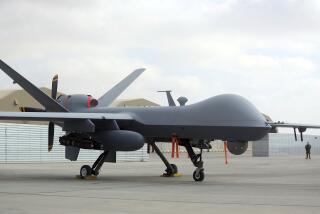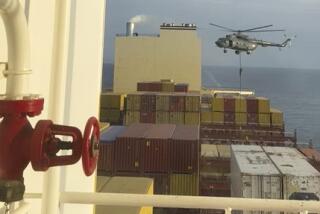Global airlines reroute flights after Iranâs downing of U.S. drone
Reporting from DUBAI, United Arab Emirates â Major airlines around the world on Friday began rerouting their flights to avoid areas around the Strait of Hormuz following Iranâs shooting down of a U.S. military surveillance drone there, as Washington warned that commercial airliners could be mistakenly attacked.
The Federal Aviation Administration warned of a âpotential for miscalculation or misidentificationâ in the region after an Iranian surface-to-air missile on Thursday brought down a U.S. Navy RQ-4A Global Hawk, an unmanned aircraft with a wingspan larger than a Boeing 737 jetliner and costing over $100 million. The U.S. said it made plans for limited strikes on Iran in response, but then called them off.
Australiaâs Qantas, British Airways, Dutch carrier KLM, Emirates, Germanyâs Lufthansa, Malaysia Airlines and Singapore Airlines said soon afterward that they will avoid the region.
The FAA previously warned of a risk in the region, but Fridayâs warning threw into stark relief a danger that both the agency and analysts say is real after the shooting down of a Malaysian Airlines flight over Ukraine in 2014. That could further imperil the bottom lines of Persian Gulf long-haul carriers, which already have faced challenges under the Trump administration.
âThe threat of a civil aircraft shootdown in southern Iran is real,â warned a statement from OPSGROUP, a company that provides guidance to global airlines.
The FAA made a similar warning in May to commercial airliners of the possibility of Iranian antiaircraft gunners mistaking them for military aircraft, something dismissed by Tehran some 30 years after the U.S. Navy shot down an Iranian passenger jet.
Iran had no immediate reaction to the U.S. announcement.
The FAA said its warning would affect the area of the Tehran Flight Information Region, without elaborating. The FAAâs operations center referred questions to its media office, which did not immediately respond to queries from the Associated Press. However, the area in question likely only extends about 12 miles off of the Iranian coast, aviation experts said.
There are âheightened military activities and increased political tensions in the region, which present an inadvertent risk to U.S. civil aviation operations and potential for miscalculation or misidentification,â the FAA said. âThe risk to U.S. civil aviation is demonstrated by the Iranian surface-to-air missile shoot-down of a U.S. unmanned aircraft system on 19 June 2019 while it was operating in the vicinity of civil air routes above the Gulf of Oman.â
Qantas said it would reroute its London flights to avoid the Strait of Hormuz and Gulf of Oman. British Airways, KLM, Malaysia Airlines and Singapore Airlines said their flights would avoid the strait. Lufthansa said it would avoid both the Strait of Hormuz and the Gulf of Oman, as well as nearby land. However, it said it would continue its flights to Tehran.
The Persian Gulf is home to some of the worldâs top long-haul carriers, who already have been battered by the Trump administrationâs travel bans targeting a group of predominantly Muslim countries, as well as an earlier ban on laptops in airplane cabins for Mideast carriers. Etihad, the Abu Dhabi-based long-haul carrier, said it had âcontingency plansâ in place, without elaborating.
âWe will decide what further action is required after carefully evaluating the FAA directive to U.S. carriers,â the carrier told the Associated Press.
Emirates, the long-haul carrier in Dubai near the Strait of Hormuz, said in a statement to AP that it was ârerouting all flights away from areas of possible conflict.â Its sister airline, the low-cost carrier FlyDubai, said it âadjusted some of the existing flight paths in the region as a precautionary measure.â
Qatar Airways did not immediately respond to requests for comment.
Iran said the drone âviolatedâ its territorial airspace, while the U.S. called the missile fire âan unprovoked attackâ in international airspace over the Strait of Hormuz, the narrow mouth of the Persian Gulf. OPSGROUP said the Iranian weapons system that shot down the drone was comparable to the Russian Buk system used in 2014 Malaysian Airlines shootdown in Ukraine.
âAny error in that system could cause it to find another target nearby â another reason not to be anywhere near this part of the Straits of Hormuz,â OPSGROUP said.
More to Read
Sign up for Essential California
The most important California stories and recommendations in your inbox every morning.
You may occasionally receive promotional content from the Los Angeles Times.










